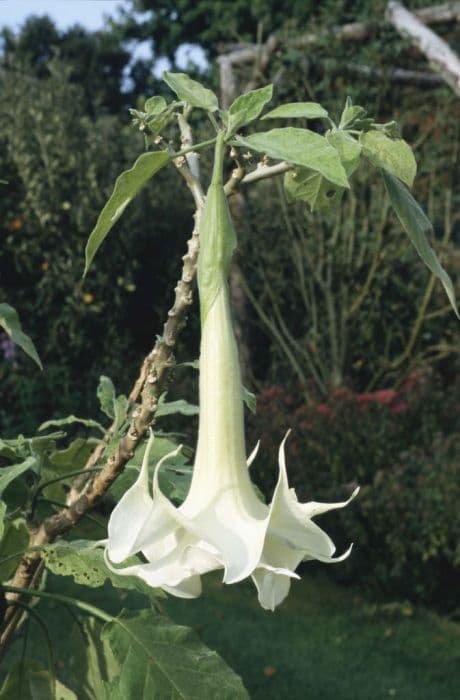Flowering Tobacco Nicotiana Domino Series

ABOUT
The Nicotiana Domino Series, commonly known as flowering tobacco, is noted for its attractive, star-shaped flowers. These blossoms come in a variety of colors including shades of pink, red, white, and lime-green, often with a pleasant fragrance that intensifies in the evening. The plant carries these flowers at the top of its stalks, and they tend to be densely clustered, creating a rich display of color. The foliage of the flowering tobacco is a lush green, with leaves that are generally large and somewhat sticky to the touch. The plant's overall form is upright, and it has a well-branched structure, allowing it to bear a heavy load of flowers. The leaves are ovate to lance-shaped and can have slightly wavy edges. This series is known for its ornamental value and is used in gardens and landscapes for mass plantings, borders, or as a focal point due to its showy and aromatic flowers. The plant is also popular for nighttime gardens or moon gardens, where its fragrance can be particularly enjoyed during the evening hours.
About this plant
 Names
NamesFamily
Solanaceae
Synonyms
Flowering Tobacco, Ornamental Tobacco
Common names
Nicotiana alata 'Domino Series'
 Toxicity
ToxicityTo humans
The Flowering Tobacco plant contains toxic alkaloids, including nicotine. Ingestion of any part of the plant can lead to nicotine poisoning. Symptoms of poisoning may include nausea, vomiting, diarrhea, sweating, dizziness, headaches, and difficulty breathing. In severe cases, convulsions, a drop in blood pressure, and respiratory failure can occur, which may be fatal if medical treatment is not promptly administered.
To pets
The Flowering Tobacco plant is also toxic to pets due to the presence of nicotine and other alkaloids. If a pet ingests any part of the plant, symptoms such as vomiting, diarrhea, hyperactivity, tremors, and seizures may occur. In extreme cases, ingestion can lead to paralysis, respiratory failure, and potentially death. Immediate veterinary attention is crucial if poisoning is suspected.
 Characteristics
CharacteristicsLife cycle
Annuals
Foliage type
Deciduous
Color of leaves
Green
Flower color
Varies
Height
1-2 feet (30-60 cm)
Spread
1 foot (30 cm)
Plant type
Herb
Hardiness zones
10
Native area
South America
Benefits
 General Benefits
General Benefits- Ornamental Value: The Nicotiana Domino Series, also known as Flowering Tobacco, features vibrant flowers that add aesthetic appeal to gardens and landscapes.
- Aromatic Flowers: Flowering Tobacco emits a pleasant fragrance, especially in the evenings, which can enhance the sensory experience of a garden.
- Attracts Pollinators: These plants are known to attract beneficial pollinators such as hummingbirds, bees, and butterflies, supporting biodiversity.
- Easy to Grow: The Domino Series is generally easy to cultivate, making it suitable for gardeners of all skill levels.
- Extended Blooming: These plants have a long flowering period, which can provide color and interest in the garden throughout the growing season.
- Versatile Planting Options: They can be planted in garden beds, borders, containers, and as part of mass plantings, offering versatility in garden design.
- Drought Tolerant: Once established, Nicotiana plants in the Domino Series often exhibit some drought tolerance, reducing the need for frequent watering.
- Evening Interest: Their tendency to release fragrance in the evening and night-time appeal can create a pleasant atmosphere for outdoor evenings.
- Variety of Colors: Available in multiple colors, the Domino Series allows gardeners to choose the hues that best fit their garden's color scheme.
 Medical Properties
Medical PropertiesThis plant is not used for medical purposes.
 Air-purifying Qualities
Air-purifying QualitiesThis plant is not specifically known for air purifying qualities.
 Other Uses
Other Uses- Nicotiana, also known as flowering tobacco, can be used in floral arrangements to add height and a distinct, trumpet-like appearance that can make bouquet creations more visually interesting.
- Insectary planting: Nicotiana is known to attract beneficial insects such as predatory wasps and ladybugs to the garden, which can help control pest populations.
- As a natural pest deterrent, the strong scent of Nicotiana can be used in the garden to repel certain insects like aphids and whiteflies from more susceptible plants.
- Nicotiana's sticky foliage has been observed to occasionally trap small insects, which may serve as an unintentional form of pest control.
- Photography and art projects can benefit from the vibrant colors and unique shape of Nicotiana flowers as subject matter to create interesting compositions.
- Traditional ceremonies: In some cultures, Nicotiana may be used decoratively in various ceremonies for its aesthetic appeal and symbolic meanings.
- Educational use: Teachers and educators might use Nicotiana in botany lessons to demonstrate plant growth, flower anatomy, and pollination processes.
- Seed saving: Garden hobbyists might collect Nicotiana seeds to preserve specific horticultural varieties or engage in seed exchange communities.
- As a transitional plant in garden design, Nicotiana can be used to provide a visual bridge between low-lying plants and taller shrubbery or trees.
- Privacy screens: When mass-planted, Nicotiana can create a temporary screen or visual barrier in the garden during the summer months.
Interesting Facts
 Feng Shui
Feng ShuiThe Nicotiana is not used in Feng Shui practice.
 Zodiac Sign Compitability
Zodiac Sign CompitabilityThe Nicotiana is not used in astrology practice.
 Plant Symbolism
Plant Symbolism- Attraction: The Nicotiana Domino Series, commonly known as Flowering Tobacco, often symbolizes magnetism or allure due to its bright, trumpet-shaped flowers and strong fragrance that draws people and pollinators alike.
- Warning: As a member of the tobacco family, Flowering Tobacco may also represent caution or danger, alluding to the toxic properties of tobacco and the plant itself if ingested.
- Healing: Despite its toxicity, Flowering Tobacco has been used in traditional medicine, symbolizing healing and the duality of plants being both beneficial and harmful.
- Peace: The soothing scent of Flowering Tobacco can symbolize peace and relaxation, calming the senses and providing a serene atmosphere.
- Fertility: The abundant blossoms of the Flowering Tobacco plant symbolize fertility and productivity, a common association for many flowering plants in various cultures.
 Water
WaterThe flowering tobacco, or Nicotiana, should be watered regularly to maintain moist, but not waterlogged, soil. In general, provide about 1 inch of water weekly, either through rainfall or manual watering. During hot, dry spells, you may need to water the plants two to three times per week. It's best to water them deeply, which encourages roots to grow deeper into the ground, making the plant more drought-resistant. Avoid overhead watering to reduce the risk of leaf diseases; instead, water at the base of the plant. The exact amount of water may vary based on soil type and weather conditions, so always check the soil moisture level before watering.
 Light
LightFlowering tobacco thrives in full sun to partial shade. It will produce the most abundant blooms when placed in a spot that receives at least six hours of direct sunlight each day. However, in very hot climates, the plants will appreciate some afternoon shade to protect them from the intense heat of the late day sun. Avoid overly shaded areas, as this can lead to sparse flowering and leggy stems.
 Temperature
TemperatureFlowering tobacco prefers warm temperatures and will grow best when daytime temperatures are between 70°F and 85°F. It can survive minimum temperatures down to about 60°F at night. Be cautious of frosts, as flowering tobacco is sensitive to cold and cannot survive temperatures below freezing. Ideal growing conditions are within the listed temperature range, avoiding exposure to temperatures below 32°F, which could be harmful or fatal to the plant.
 Pruning
PruningFlowering tobacco should be pruned to promote bushy growth and more abundant blooms. Pinch back the tips of young plants to encourage branching. Deadhead spent flowers regularly to induce continued blooming throughout the season. The best time to prune for shaping is early in the growing season; however, deadheading can be done whenever necessary during the blooming period.
 Cleaning
CleaningAs needed
 Soil
SoilFlowering Tobacco prefers well-drained, fertile soil with a pH between 6.0 and 7.0. A mix of loam, peat, and perlite works well to ensure adequate drainage and nutrient retention.
 Repotting
RepottingFlowering Tobacco, grown as annuals, don't typically require repotting. If started in containers, they may be planted out in the garden after frost.
 Humidity & Misting
Humidity & MistingFlowering Tobacco thrives in average humidity conditions typical of outdoor environments, without special requirements for added humidity.
 Suitable locations
Suitable locationsIndoor
Place Flowering Tobacco in bright, indirect light, and keep the soil moist.
Outdoor
Plant Flowering Tobacco in partial shade to full sun, in rich soil.
Hardiness zone
10-11 USDA
 Life cycle
Life cycleThe life cycle of the Nicotiana Domino Series, commonly known as the flowering tobacco, begins with seed germination which typically occurs in warm, moist soil conditions, usually in spring or under controlled conditions. Upon sprouting, the seedlings grow into young plants with a rosette of basal leaves; this vegetative stage is characterized by rapid foliar growth. As the plants mature, they develop a sturdy stem and a larger leaf structure, preparing for the reproductive phase. Flowering tobacco then enters its flowering stage in the early summer to late summer, producing tubular flowers that are well-known for their fragrance and attractiveness to pollinating insects. Following pollination, the plant sets seed inside elongated capsules that eventually dry and release seeds for the next generation. After seed dispersal, the plant completes its annual life cycle, dying back with the onset of colder weather, relying on the seeds for propagation.
 Propogation
PropogationPropogation time
Spring-Early Summer
The most popular method for propagating Nicotiana, commonly known as Flowering Tobacco, is by seed. Seeds should be sown early in the year, typically around 8-10 weeks before the last frost date. It is important to not cover the seeds with soil as they require light for germination. Instead, simply press them into the surface of a moist seed starting mix. Keep the seed trays at a temperature of about 70 to 75 degrees Fahrenheit (21 to 24 degrees Celsius), and maintain moisture without causing the soil to become waterlogged. Seedlings usually emerge in 10 to 20 days. After the danger of frost has passed and the seedlings are large enough to handle, they can be transplanted outdoors into the garden or into containers.


![Calibrachoa [Aloha Classic Blue Sky]](/_next/image?url=https%3A%2F%2Fplants-admin.emdemapps.com%2Fimages%2Fplants%2F%2Fimages%2F604b636c3778b.png&w=640&q=75)
![Calibrachoa [Aloha Classic Gold]](/_next/image?url=https%3A%2F%2Fplants-admin.emdemapps.com%2Fimages%2Fplants%2F%2Fimages%2F604b6284c573e.png&w=640&q=75)
![Calibrachoa [Aloha Classic Tiki Soft Pink]](/_next/image?url=https%3A%2F%2Fplants-admin.emdemapps.com%2Fimages%2Fplants%2F%2Fimages%2F604b548e0a5ef.png&w=640&q=75)
![Calibrachoa [Cabaret Deep Yellow]](/_next/image?url=https%3A%2F%2Fplants-admin.emdemapps.com%2Fimages%2Fplants%2F%2Fimages%2F604b5f20ca3ef.png&w=640&q=75)
![Calibrachoa [Calibasket Radiant Orange]](/_next/image?url=https%3A%2F%2Fplants-admin.emdemapps.com%2Fimages%2Fplants%2F%2Fimages%2F604b536d43cb2.png&w=640&q=75)
![Calibrachoa [Caloha Classic Blue Velvet]](/_next/image?url=https%3A%2F%2Fplants-admin.emdemapps.com%2Fimages%2Fplants%2F%2Fimages%2F604b604884a75.png&w=640&q=75)
![Calibrachoa [Caloha Classic Honey White]](/_next/image?url=https%3A%2F%2Fplants-admin.emdemapps.com%2Fimages%2Fplants%2F%2Fimages%2F604b5f56e0beb.png&w=640&q=75)
![Calibrachoa [Caloha Classic Yellow Chocolate Ring]](/_next/image?url=https%3A%2F%2Fplants-admin.emdemapps.com%2Fimages%2Fplants%2F%2Fimages%2F604b538aede95.png&w=640&q=75)